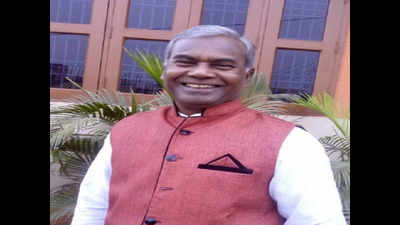- News
- City News
- patna News
- Bihar: Supaul man who laid first brick of Ram temple is elated
Trending
This story is from November 10, 2019
Bihar: Supaul man who laid first brick of Ram temple is elated
Kameshwar Chaupal, who had laid the first brick at the then disputed site for construction of Ramlala temple at Ayodhya in 1989, is elated over the Supreme Court verdict on Saturday.

Kameshwar Chaupal
PATNA: Kameshwar Chaupal, who had laid the first brick at the then disputed site for construction of Ramlala temple at Ayodhya in 1989, is elated over the Supreme Court verdict on Saturday.
“The scene at Ayodhya on November 9, 1989 is still fresh in my mind. The honour that I was bestowed with as a Vishwa Hindu Parishad (VHP) member at the age of 35 is a memorable one,” Chaupal, who was made an MLC after that incident, told this newspaper.
The man belonging to a Dalit family of Supaul in Bihar and now a member of the state BJP working committee said, “I had been waiting for this moment for the last three decades.For me, the verdict is like a dream come true. Now my life has come full circle.”
The 65-year-old Chaupal turned emotional while recalling the foundation laying incident. “Not only the saints of different religious trusts and groups but prominent BJP leaders were witness to the foundation laying ceremony. There are around 3,000 temples in Ayodhya and priests and saints of those temples besides people from across the country as ‘kar sevaks’ had gathered on the occasion. I was asked by the saints and priests to lay the first brick for the Ramlala temple in the holy city,” he said, adding that he was then deputy secretary of the VHP in undivided Bihar.
Describing the factors leading to the laying of foundation stone, Chaupal said the then Congress led government at the Centre was under pressure due to the much publicized Shah Bano case (Muslim women’s fight for their right). In November 1989, then Prime Minister Rajiv Gandhi allowed the Hindu organizations to lay the foundation stone near the disputed site to dispel the notion that his party was pro-Muslim.
“As far as I recall, the VHP had already launched a campaign to garner the support of the Hindus for the Ramlala temple. It had also given a call for ‘kar seva’ and invited people to Ayodhya with bricks collected from every nook and corner. On November 9, 1989, the foundation stone was laid. I placed the first brick. What a historic moment it was,” he added.
“The scene at Ayodhya on November 9, 1989 is still fresh in my mind. The honour that I was bestowed with as a Vishwa Hindu Parishad (VHP) member at the age of 35 is a memorable one,” Chaupal, who was made an MLC after that incident, told this newspaper.
The man belonging to a Dalit family of Supaul in Bihar and now a member of the state BJP working committee said, “I had been waiting for this moment for the last three decades.For me, the verdict is like a dream come true. Now my life has come full circle.”
The 65-year-old Chaupal turned emotional while recalling the foundation laying incident. “Not only the saints of different religious trusts and groups but prominent BJP leaders were witness to the foundation laying ceremony. There are around 3,000 temples in Ayodhya and priests and saints of those temples besides people from across the country as ‘kar sevaks’ had gathered on the occasion. I was asked by the saints and priests to lay the first brick for the Ramlala temple in the holy city,” he said, adding that he was then deputy secretary of the VHP in undivided Bihar.
Chaupal said he had come in contact with the functionaries of Shri Ram Janmabhoomi Mukti Yajna Samiti, which had taken out a procession from Sitamarhi, stated to be the birthplace of Sita. Later, he met Mahanth Avaidyanath, the chief of the samiti.
Describing the factors leading to the laying of foundation stone, Chaupal said the then Congress led government at the Centre was under pressure due to the much publicized Shah Bano case (Muslim women’s fight for their right). In November 1989, then Prime Minister Rajiv Gandhi allowed the Hindu organizations to lay the foundation stone near the disputed site to dispel the notion that his party was pro-Muslim.
“As far as I recall, the VHP had already launched a campaign to garner the support of the Hindus for the Ramlala temple. It had also given a call for ‘kar seva’ and invited people to Ayodhya with bricks collected from every nook and corner. On November 9, 1989, the foundation stone was laid. I placed the first brick. What a historic moment it was,” he added.
End of Article
FOLLOW US ON SOCIAL MEDIA










